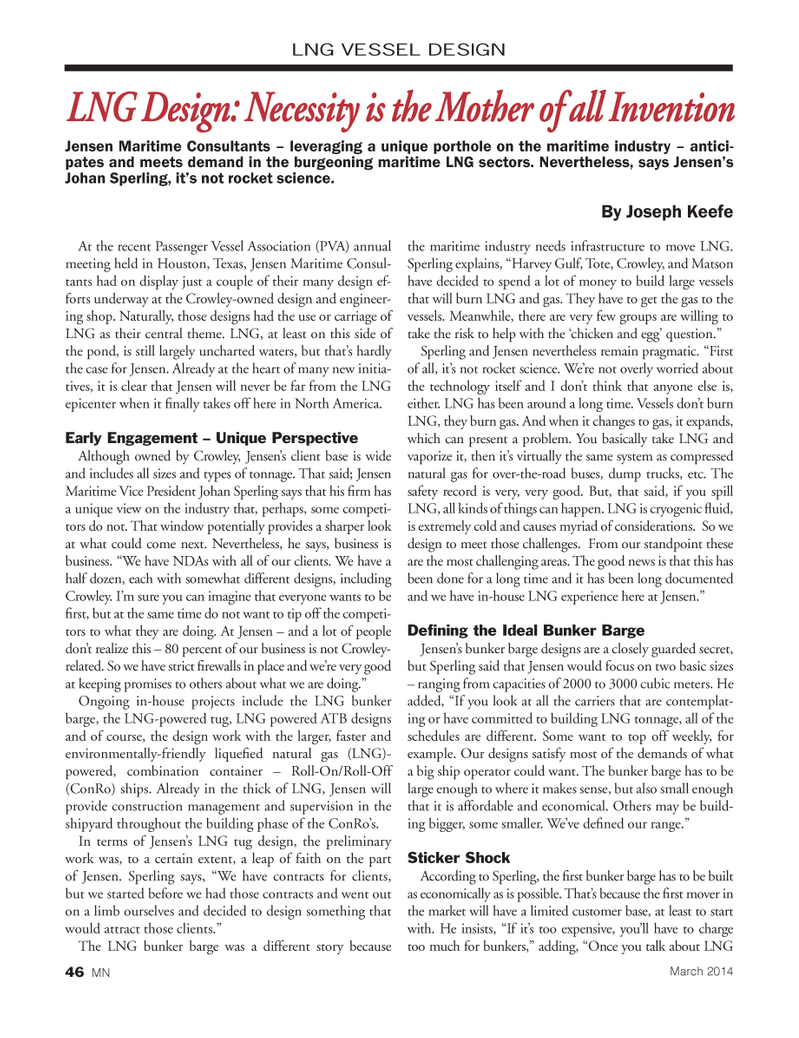
Page 46: of Marine News Magazine (March 2014)
Fleet & Vessel Optimization
Read this page in Pdf, Flash or Html5 edition of March 2014 Marine News Magazine
At the recent Passenger Vessel Association (PVA) annual meeting held in Houston, Texas, Jensen Maritime Consul- tants had on display just a couple of their many design ef- forts underway at the Crowley-owned design and engineer- ing shop. Naturally, those designs had the use or carriage of
LNG as their central theme. LNG, at least on this side of the pond, is still largely uncharted waters, but that’s hardly the case for Jensen. Already at the heart of many new initia- tives, it is clear that Jensen will never be far from the LNG epicenter when it fi nally takes off here in North America.
Early Engagement – Unique Perspective
Although owned by Crowley, Jensen’s client base is wide and includes all sizes and types of tonnage. That said; Jensen
Maritime Vice President Johan Sperling says that his fi rm has a unique view on the industry that, perhaps, some competi- tors do not. That window potentially provides a sharper look at what could come next. Nevertheless, he says, business is business. “We have NDAs with all of our clients. We have a half dozen, each with somewhat different designs, including
Crowley. I’m sure you can imagine that everyone wants to be fi rst, but at the same time do not want to tip off the competi- tors to what they are doing. At Jensen – and a lot of people don’t realize this – 80 percent of our business is not Crowley- related. So we have strict fi rewalls in place and we’re very good at keeping promises to others about what we are doing.”
Ongoing in-house projects include the LNG bunker barge, the LNG-powered tug, LNG powered ATB designs and of course, the design work with the larger, faster and environmentally-friendly liquefi ed natural gas (LNG)- powered, combination container – Roll-On/Roll-Off (ConRo) ships. Already in the thick of LNG, Jensen will provide construction management and supervision in the shipyard throughout the building phase of the ConRo’s.
In terms of Jensen’s LNG tug design, the preliminary work was, to a certain extent, a leap of faith on the part of Jensen. Sperling says, “We have contracts for clients, but we started before we had those contracts and went out on a limb ourselves and decided to design something that would attract those clients.”
The LNG bunker barge was a different story because the maritime industry needs infrastructure to move LNG.
Sperling explains, “Harvey Gulf, Tote, Crowley, and Matson have decided to spend a lot of money to build large vessels that will burn LNG and gas. They have to get the gas to the vessels. Meanwhile, there are very few groups are willing to take the risk to help with the ‘chicken and egg’ question.”
Sperling and Jensen nevertheless remain pragmatic. “First of all, it’s not rocket science. We’re not overly worried about the technology itself and I don’t think that anyone else is, either. LNG has been around a long time. Vessels don’t burn
LNG, they burn gas. And when it changes to gas, it expands, which can present a problem. You basically take LNG and vaporize it, then it’s virtually the same system as compressed natural gas for over-the-road buses, dump trucks, etc. The safety record is very, very good. But, that said, if you spill
LNG, all kinds of things can happen. LNG is cryogenic fl uid, is extremely cold and causes myriad of considerations. So we design to meet those challenges. From our standpoint these are the most challenging areas. The good news is that this has been done for a long time and it has been long documented and we have in-house LNG experience here at Jensen.”
Defi ning the Ideal Bunker Barge
Jensen’s bunker barge designs are a closely guarded secret, but Sperling said that Jensen would focus on two basic sizes – ranging from capacities of 2000 to 3000 cubic meters. He added, “If you look at all the carriers that are contemplat- ing or have committed to building LNG tonnage, all of the schedules are different. Some want to top off weekly, for example. Our designs satisfy most of the demands of what a big ship operator could want. The bunker barge has to be large enough to where it makes sense, but also small enough that it is affordable and economical. Others may be build- ing bigger, some smaller. We’ve defi ned our range.”
Sticker Shock
According to Sperling, the fi rst bunker barge has to be built as economically as is possible. That’s because the fi rst mover in the market will have a limited customer base, at least to start with. He insists, “If it’s too expensive, you’ll have to charge too much for bunkers,” adding, “Once you talk about LNG
LNG VESSEL DESIGN
LNG Design: Necessity is the Mother of all InventionLNG Design: Necessity is the Mother of all Invention
Jensen Maritime Consultants – leveraging a unique porthole on the maritime industry – antici- pates and meets demand in the burgeoning maritime LNG sectors. Nevertheless, says Jensen’s
Johan Sperling, it’s not rocket science.
By Joseph Keefe 46 MN
March 2014
MN MAR14 Layout 32-49.indd 46 2/21/2014 3:29:34 PM

 45
45

 47
47
